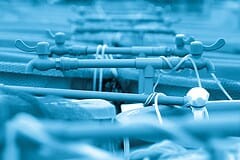Recirculation aquaculture, at its core, is a sophisticated technology designed for cultivating fish or other aquatic life by recycling water within the production process. This method relies on mechanical and biological filtration systems and can theoretically be applied to any species raised in aquaculture, including fish, shrimp, and shellfish. However, recirculation technology finds its primary application in fish farming, and this guide is specifically geared towards individuals involved in this particular sector of aquaculture.

An overview of a typical Recirculating Aquaculture System (RAS) setup.
Recirculation aquaculture systems (RAS) are experiencing rapid growth across various segments of the fish farming industry. These systems are implemented in production facilities that range from large-scale operations producing substantial quantities of fish annually for consumption to smaller, more specialized setups used for restocking purposes or for the conservation of endangered species.
The intensity of recirculation can vary depending on the amount of water that is recirculated and reused. Some fish farms operate as super-intensive systems housed within enclosed, insulated buildings, utilizing as little as 300 liters of new water (or even less) per kilogram of fish produced per year. Conversely, other farms may be traditional outdoor facilities that have been retrofitted into recirculating systems, using approximately 3 cubic meters of new water per kilogram of fish produced annually. In comparison, a conventional flow-through system for trout farming typically consumes around 30 cubic meters of new water per kilogram of fish produced each year. For instance, a fish farm producing 500 tonnes of fish annually would require 17 m3/hour, 171 m3/hour, or 1,712 m3/hour of new water, respectively, based on the examples provided, highlighting a significant disparity.
Another method for quantifying the degree of recirculation is through the following formula:
(Internal recirculation flow / (internal recirculation flow + new water intake)) x 100
Environmental Benefits of Recirculation Aquaculture
From an environmental perspective, the reduced water consumption in recirculation aquaculture is highly advantageous, particularly in regions where water is a scarce resource. Moreover, the limited water usage simplifies and reduces the cost of removing nutrients excreted by the fish, as the volume of discharged water is considerably lower compared to traditional fish farms. Consequently, recirculation aquaculture can be regarded as an environmentally responsible method of fish production that is commercially viable. The nutrients extracted from the farmed fish can be repurposed as fertilizer for agricultural land or as a substrate for biogas production.
While the term “zero-discharge” is sometimes associated with fish farming, achieving complete elimination of sludge and water discharge from a farm can be prohibitively expensive due to the complexity of treating residual concentrations in wastewater. Therefore, applications for nutrient and water discharge should always be included as part of the planning permission process.
.jpeg)
A biofilter component within a Recirculating Aquaculture System (RAS).
Production Benefits of Recirculation Aquaculture
Most notably, the minimal water usage provides significant benefits to the production process within the fish farm. Traditional fish farming relies heavily on external factors such as river water temperature, water quality, oxygen levels, and the presence of debris that can obstruct inlet screens. In a recirculating system, these external influences are either entirely or partially mitigated, depending on the level of recirculation and the design of the facility.
Recirculation empowers fish farmers to exert complete control over all production parameters, making their operational expertise in managing the recirculation system as critical as their fish husbandry skills.
Enhanced Control and Predictability
By controlling parameters such as water temperature, oxygen saturation, and lighting, fish farmers can create stable and optimal conditions for their stock. This leads to reduced stress and improved growth rates. These stable conditions result in predictable growth patterns, enabling farmers to accurately forecast when the fish will reach a specific stage or size. The primary benefit of this predictability is the ability to create precise production plans and accurately estimate when the fish will be ready for sale. This streamlined management process enhances the farm’s overall efficiency and strengthens its competitive position in the market.
Disease Management in Recirculation Aquaculture
There are numerous other advantages to adopting recirculation technology in fish farming, which will be explored in greater detail in subsequent sections of this guide. However, one crucial aspect to highlight is disease control.
The risk of pathogen introduction is significantly reduced in a recirculation system due to the limited water usage, which minimizes the potential for invasive diseases from the external environment. Traditional fish farms draw water from rivers, lakes, or the sea, which naturally increases the likelihood of introducing diseases.
Reduced Disease Risk and Medication Use
Due to the reduced water requirement in recirculation systems, water is typically sourced from boreholes, drainage systems, or springs, where the risk of disease contamination is minimal. Consequently, many recirculation systems experience virtually no disease outbreaks, leading to a substantial reduction in the use of medication, benefiting both the production process and the environment.
To maintain this level of disease control, it is essential for fish farmers to exercise caution when introducing eggs or fry to their farms.
Many diseases are introduced into systems through the introduction of infested eggs or fish for stocking purposes. The most effective way to prevent disease introduction is to avoid bringing in fish from external sources and instead rely solely on eggs, as these can be thoroughly disinfected.
Conclusion: Embracing Recirculation Aquaculture
Aquaculture demands knowledge, sound management practices, perseverance, and resilience. Transitioning from conventional fish farming to recirculation aquaculture simplifies many aspects of the production process, but it also necessitates the acquisition of new and advanced skills. Success in this sophisticated form of aquaculture requires dedicated training and education, which this guide aims to provide.
Further Reading
You can view the full report by clicking here.
